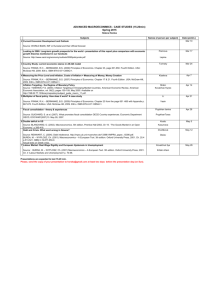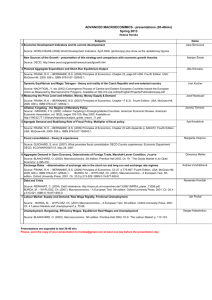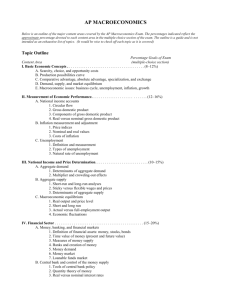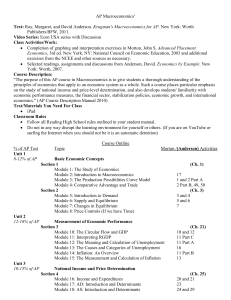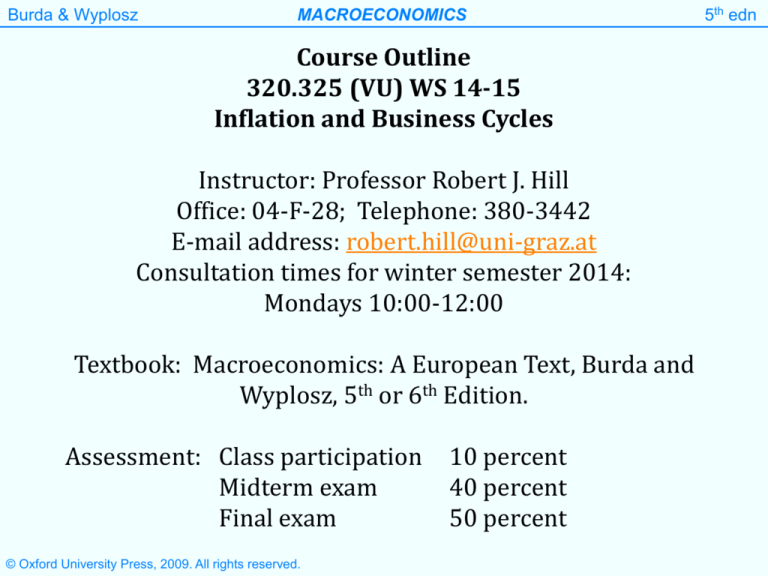
Burda & Wyplosz
MACROECONOMICS
Course Outline
320.325 (VU) WS 14-15
Inflation and Business Cycles
Instructor: Professor Robert J. Hill
Office: 04-F-28; Telephone: 380-3442
E-mail address: robert.hill@uni-graz.at
Consultation times for winter semester 2014:
Mondays 10:00-12:00
Textbook: Macroeconomics: A European Text, Burda and
Wyplosz, 5th or 6th Edition.
Assessment: Class participation
Midterm exam
Final exam
© Oxford University Press, 2009. All rights reserved.
10 percent
40 percent
50 percent
5th edn
Burda & Wyplosz
MACROECONOMICS
5th edn
Provisional Lecture Schedule
Week 1 – (29 October 2014) – Lecture on Chapter 12
Week 2 – (5 November 2014) – Tutorial covering material
from Chapter 12
Week 3 – (12 November 2014) – Lecture on Chapter 13
Week 4 – (19 November 2014) – Tutorial covering material
from Chapter 13
Week 5 – (26 November 2014) – Lecture on Chapter 14
2
© Oxford University Press, 2009. All rights reserved.
Burda & Wyplosz
MACROECONOMICS
5th edn
Week 6 – (3 December 2014) – Tutorial covering material
from Chapter 14
Week 7 – (10 December 2014) – Midterm Exam
Week 8 – (17 December 2014) – Lecture on Chapter 15
Week 9 – (7 January 2015) – Tutorial covering material
from Chapter 15
Week 10 – (14 January 2014) – Lecture on Chapters 16
and 17
3
© Oxford University Press, 2009. All rights reserved.
Burda & Wyplosz
MACROECONOMICS 5/e
Week 11 – (21 January 2015) – Tutorial covering material
from Chapters 16 and 17
Week 12 – (22 January 2015) – Lecture and tutorial
covering material from Chapter 18
Week 13 – (28 January 2015) – Final Exam
4
Burda & Wyplosz
MACROECONOMICS
Lecture 1
Chapter 12
Output, Employment,
and Inflation
© Oxford University Press, 2009. All rights reserved.
5th edn
Burda & Wyplosz
MACROECONOMICS 5/e
Figure 12.01
From the short to the long run
One-off increase in
the money supply
M
M
Short-run: prices are
sticky, output responds
to change in demand
Y
Y
P
Neoclassical long-run:
change in money results
in no change in output,
only a change in the
price level.
P
Time
© Oxford University Press, 2009. All rights reserved.
6
Burda & Wyplosz
MACROECONOMICS 5/e
An increase in the real money supply pushes down the
equilibrium interest rate in the money market for any given
level of Y, thus shifting the LM curve to the right. The fall in
the interest rate causes investment and hence equilibrium
Y to rise.
7
Burda & Wyplosz
MACROECONOMICS 5/e
Figure 12.04
Phillips curves: The UK, 1888-1975 and
a 16-country average, 1921-1973*
16 country average
Inflation rate (%)
UK
Unemployment rate (%)
© Oxford University Press, 2009. All rights reserved.
Unemployment rate (%)
8
*Excluding 1939-1949
Burda & Wyplosz
MACROECONOMICS 5/e
Figure 12.03
Inflation
Stylized Phillips curve
The tradeoff: reducing
inflation from the high level
at A to the lower inflation at
B comes at a cost in an
increase in unemployment.
A
B
Unemployment
Phillips curve
9
© Oxford University Press, 2009. All rights reserved.
Burda & Wyplosz
MACROECONOMICS 5/e
Figure 12.03
Stylized Phillips curve in algebra
Inflation
b U U
Phillips curve in point-slope form
U
(a) Phillips curve
Unemployment
10
© Oxford University Press, 2009. All rights reserved.
Burda & Wyplosz
MACROECONOMICS 5/e
Why might a trade off exist between inflation π and
unemployment U?
Suppose workers expect inflation to be at the level .
They take this into account when they negotiate wage rises
for the next period.
If the actual rate of inflation π is lower than , then real
wages are higher than expected.
This causes firms to cut output and fire some of their
employees.
The fall in inflation therefore causes unemployment to rise.
Similarly, unemployment falls when inflation rises.
11
Burda & Wyplosz
MACROECONOMICS 5/e
Phillips curve plots inflation against unemployment
(π – ) = –b(U – Ū)
Okun‘s law plots unemployment against output
U – Ū = -h(Y – Ỹ)/Ỹ
Aggregate supply curve plots inflation against output
(π – ) = g(Y – Ỹ)/Ỹ
12
Burda & Wyplosz
MACROECONOMICS 5/e
12.3.2 Okun’s Law and a supply curve interpretation
Okun’s Law is the relatively stable empirical relationship
U U h Y Y Y
where 0<h<1
There are two reasons why h<1:
(i) The labour force expands in booms and declines in
recessions
(ii) Firms tend to hoard labour in recessions
13
Burda & Wyplosz
MACROECONOMICS 5/e
Figure 12.05
Output gaps and unemployment in Germany
(1966-2007)
4
3
2
1
0
-1
-2
-3
Output gap
-4
Unemployment gap
-5
1966 1970 1974 1978 1982 1986 1990 1994 1998 2002 2006
© Oxford University Press, 2009. All rights reserved.
14
Burda & Wyplosz
MACROECONOMICS 5/e
Figure 12.06
Okun’s Law
Ygap
Ugap
U U
Ugap
U
Y Y
h
Y
h
U U Y Y
Y
j
Y
Output
U U j Y Y
Okun's Law in point-slope form
15
© Oxford University Press, 2009. All rights reserved.
Burda & Wyplosz
MACROECONOMICS 5/e
Figure 12.07
Phillips curve + Okun’s law = Aggregate Supply
b U U
Phillips curve in point-slope form
U U j Y Y
Okun's law in point-slope form
b j Y Y b j Y Y Y
g
a
Y
Ygap
Aggregate supply curve
© Oxford University Press, 2009. All rights reserved.
Note: the product of two negative slopes
became a positive slope!
16
Burda & Wyplosz
MACROECONOMICS 5/e
Figure 12.07
g Y Y
b U U
Aggregate supply curve
Inflation
Inflation
Simple Phillips curve
U
Unemployment
(a) Phillips curve
Y Output
(b) Aggregate supply
17
© Oxford University Press, 2009. All rights reserved.
Burda & Wyplosz
MACROECONOMICS 5/e
Figure 12.09
Phillips curves: Recent experience
Euroland and the UK
Euroland (1970-2007)
UK (1960-2007)
18
© Oxford University Press, 2009. All rights reserved.
Source: OECD
Burda & Wyplosz
MACROECONOMICS 5/e
Figure 12.08
Inflation
Inflation
The long run
U
(a) Phillips curve
Unemployment
Y
Output
(b) Aggregate supply
19
© Oxford University Press, 2009. All rights reserved.
Burda & Wyplosz
MACROECONOMICS 5/e
The Phillips Curve in the 1970s
In the 1970s many countries experienced stagflation. This
is not consistent with the Phillips curve? Why did this happen?
The underlying rate of inflation and the natural rate of
unemployment Ū in the Phillips curve are endogenous (i.e.,
they can change over time).
Hence the Phillips curve shifts over time.
Here we focus on factors that can cause the underlying rate
of inflation to change over time.
Factors that can change the underlying rate of unemployment Ū will be briefly mentioned in the concluding section.
20
Burda & Wyplosz
MACROECONOMICS 5/e
Deriving the Phillips Curve from First Principles
To understand the behaviour of the Phillips curve in the
1970s it is useful to derive it from the interaction between
two markups:
(i) the price markup
θ is the price mark-up on labour costs charged by firms
(ii) wage markup.
γ is the wage mark-up on expected prices obtained by
workers
This approach shows us how is determined and why it
varies over time.
21
Burda & Wyplosz
MACROECONOMICS 5/e
The price mark-up θ on labour costs charged by firms is
calculated as follows:
Labour productivity = Y/L
L/Y = unit labour requirements
W = the wage per worker
WL/Y = W/(Y/L) = nominal unit labour costs
(i.e., the labour cost of producing one unit of output).
.
It is now assumed that firms set prices by marking-up nominal
unit labour costs by a proportion θ:
W
WL
P 1
1
Y
Y L
22
Burda & Wyplosz
MACROECONOMICS 5/e
Wage negotiations will set a nominal wage W compatible
with an expected real wage target W/Pe.
W
Y
Y
sL 1 sL
e
P
L decomposes L
share of
productivity
paid to labour
actual wage
share into two
components
The parameter γ can be positive or negative. It allows
for a deviation from the “normal” or historical share of
labour productivity that will be paid to labour.
23
Burda & Wyplosz
MACROECONOMICS 5/e
Table 12.01
Wage share of value added by country and selected
industries, 2001 (%)
Total
economy
Belgium
Manufacturing
Chemicals
Basic metal
industries
Wholesale/
retail trade
56.6
64.5
53.9
78.3
56.7
50.1
54.6
46.0
60.0
43.6
Germany
58.2
74.1
69.0
75.3
63.9
Denmark
60.1
64.5
40.4
54.1
67.9
Spain
53.1
67.3
59.7
73.3
44.5
Italy
43.7
54.6
51.9
61.6
32.6
Japan
52.6
56.1
36.3
60.9
60.2
Netherlands
56.0
59.9
45.9
78.4
60.0
Poland
49.8
61.0
n.a.
n.a.
26.1
United States
58.7
66.0
49.5
70.6
55.6
Czech Republic
a
a
a
a
2000
Source: OECD, National Accounts, Volume II
24
© Oxford University Press, 2009. All rights reserved.
Burda & Wyplosz
MACROECONOMICS 5/e
Rewriting the last equation we have:
WL
1 sL P e
Y
Substituting this wage equation into the price markup
equation, we get a relationship between the markup
factors, normal labour share, and expected price and
the actual price level.
P 1 1 sL P
e
25
Burda & Wyplosz
MACROECONOMICS 5/e
Now take logs of this equation in the current and previous
period:
ln P ln 1 ln 1 ln sL ln P e ln sL ln P e
ln P1 ln 1 1 ln 1 1 ln sL ln Pe1 1 1 ln sL ln Pe1
Subtract the second line from the first:
ln P ln P1 1 1 ln P e ln Pe1
mark-up
subtract and add
P1 here
mark-up ln P e ln P1 ln P1 ln Pe1
e
price level surprise
last period
26
Burda & Wyplosz
MACROECONOMICS 5/e
The following approximation is used on the previous
slide:
ln(1+x) ≈ x (where x is small).
It follows that
ln P – ln P-1 = ln(P/P-1) ≈ (P/P-1) –1 = (P – P-1)/P-1 = π
where x = (P/P-1)-1.
27
Burda
& Wyplosz
MACROECONOMICS 5/e
The last term in the equation below will on average be zero
(assuming rational expectations).
mark-up e ln P1 ln Pe1
price level surprise
last period
π = Δmark-up +
(*)
where denotes the underlying rate of inflation, which
combines forward looking expectations and backward
looking adaption to the last price level surprise.
It should be the case that γ rises when the economy is
booming (i.e., when Y>Ỹ and U < Ū), and falls when the
economy is in recession (i.e., when Y<Ỹ and U > Ū).
It is not clear how θ varies over the business cycle.
28
Burda & Wyplosz
MACROECONOMICS 5/e
Overall, we can reasonably assume that
Δmark-up > 0 when Y>Ỹ and U < Ū
Δmark-up < 0 when Y<Ỹ and U > Ū.
As an approximation, we can go further and assume that
the aggregate mark-up evolves as follows over the
business cycle:
Δmark-up = a(Y-Ỹ) = -b(U-Ū).
(**)
Substituting the mark-up equation (*) into (**), we obtain
that
29
Burda & Wyplosz
MACROECONOMICS 5/e
a Y Y b U U
AS
(***)
"expectations" augmented
Phillips Curve
This is what is referred to as the expectations augmented
Phillips curve.
The key difference between this and the original Phillips
curve is that the parameter is now time dependent
and defined as follows:
= πe + price level surprise last period
Hence the Phillips curve, as graphed in U-π space, shifts
around over time as πe changes.
30
Burda & Wyplosz
MACROECONOMICS 5/e
Modelling the Impact of Supply Shocks
Supply shocks, such as a rise in the price of oil, impact on
the aggregate supply curve and Phillips curve as follows:
actual
underlying
inflation
a Y Y s
cycle
shock
b U U s
In other words, supply shocks cause both the aggregate
supply curve and Phillips curve to shift upwards by the
amount of the shock s.
31
Burda & Wyplosz
MACROECONOMICS 5/e
Figure 12.11
Augmented Phillips and aggregate supply curves
Inflation
Inflation
AS
B
A
U
(a) Phillips curve
B
Unemployment
AS
A
Y
Output
(b) Aggregate supply
32
© Oxford University Press, 2009. All rights reserved.
Burda & Wyplosz
MACROECONOMICS 5/e
Figure 12.10
Oil price in euros, 1952-2007
180
(Index = 100 in 2000)
160
140
120
100
80
60
40
20
0
1952
1962
1972
1982
1992
2002
33
© Oxford University Press, 2009. All rights reserved.
Source: OECD
Burda & Wyplosz
MACROECONOMICS 5/e
Table 12.02
Equilibrium (i.e., natural) unemployment rates
Austria
1970
1980
1990
2000
2008
1970
1980
1990
2000
2008
Belgium Switzerland Germany
1.5
1.8
4.3
5.0
4.9
N/A
5.9
7.3
7.6
7.2
N/A
0.6
1.7
2.2
2.2
3.3
4.4
6.9
7.3
7.1
Hungary
Ireland
Italy
Japan
N/A
N/A
N/A
7.5
5.3
N/A
10.9
14.4
6.6
5.0
4.3
5.4
8.8
9.4
7.2
2.4
1.6
2.8
3.6
3.9
Denmark
Spain
Finland
France
UK
N/A
5.1
6.8
4.8
4.5
N/A
6.4
14.5
12.4
8.5
4.6
4.0
4.8
9.8
8.0
N/A
6.1
9.4
9.5
8.5
2.7
4.1
8.0
5.6
5.3
Portugal
Sweden
US
N/A
6.5
4.5
4.1
4.8
1.5
1.9
2.2
4.8
4.8
5.5
6.5
5.8
5.0
4.6
Netherlands Norway
N/A
4.3
7.5
4.5
3.2
1.6
1.9
3.9
3.8
4.1
The natural rate of unemployment rose in most countries in the 1970s and
then gradually decreased again in the 1990s.
34
© Oxford University Press, 2009. All rights reserved.
Source: OECD
Burda & Wyplosz
MACROECONOMICS 5/e
Figure 12.12
Suppose initially inflation equals underlying inflation.
Inflation
Long run AS
Inflation
Long run
1
A
U
(a) Phillips curve
Short run
Phillips
curve
Unemployment
Short
run
AS
1
A
Y
Output
(b) Aggregate supply
35
© Oxford University Press, 2009. All rights reserved.
Burda & Wyplosz
MACROECONOMICS 5/e
Figure 12.12
-Short-run trade-off between u and p:
Suppose aggregate demand rises (say due to the government implementing an
expansionary monetary policy)
2
1
Long run AS
Inflation
Inflation
Long run
B
A
U
(a) Phillips curve
Short run
Phillips
curve
Unemployment
2
1
B
A
Y
Short
run
AS
Output
(b) Aggregate supply
36
© Oxford University Press, 2009. All rights reserved.
Burda & Wyplosz
MACROECONOMICS 5/e
Figure 12.12
At B, inflation is not equal to underlying inflation.
Underlying inflation will adjust.
2
1
Long run AS
Inflation
Inflation
Long run
B
A
U
(a) Phillips curve
Short run
Phillips
curve
Unemployment
2
1
B
A
Y
Short
run
AS
Output
(b) Aggregate supply
37
© Oxford University Press, 2009. All rights reserved.
Burda & Wyplosz
MACROECONOMICS 5/e
Figure 12.12
As underlying inflation catches up with experience, the
Phillips curve and AS will shift.
2
1
Long run AS
Inflation
Inflation
Long run
B
A
U
(a) Phillips curve
Short run
Phillips
curves
Unemployment
2
1
B
A
Y
Short
run
AS
Output
(b) Aggregate supply
38
© Oxford University Press, 2009. All rights reserved.
Burda & Wyplosz
MACROECONOMICS 5/e
Figure 12.12
A move along “invisible” AD curve through B and C
Long run AS
Inflation
Inflation
Long run
C
2
1
B
A
U
(a) Phillips curve
Short run
Phillips
curves
Unemployment
C
2
1
B
A
Y
Short
run
AS
Output
(b) Aggregate supply
39
© Oxford University Press, 2009. All rights reserved.
Burda & Wyplosz
MACROECONOMICS 5/e
Figure 12.12
No stable long run tradeoff between unemployment and
inflation. End up at Z.
C
2
1
B
Long run AS
Z
Inflation
Inflation
Long run
A
U
(a) Phillips curve
Short run
Phillips
curves
Unemployment
Z
C
2
1
B
A
Y
Short
run
AS
Output
(b) Aggregate supply
40
© Oxford University Press, 2009. All rights reserved.
Burda & Wyplosz
MACROECONOMICS 5/e
Conclusion
The big rightward shift of the short-run Phillips curve in the
1970s and early 1980s can be explained by a combination of
the following:
(i) A negative supply shock caused by the rise in the price of
oil triggered a series of rises in the underlying rate of
inflation. Rises in oil costs caused firms to raise prices
which in turn caused workers to demand higher wages,
which caused firms to further raise prices, etc.
(ii) Attempts by governments to exploit the Phillips curve
and trade-off higher inflation in return for lower
unemployment.
(iii) A rise in the natural rate of unemployment (due to oilshock induced changes in economic structure and
hysteresis).
41

